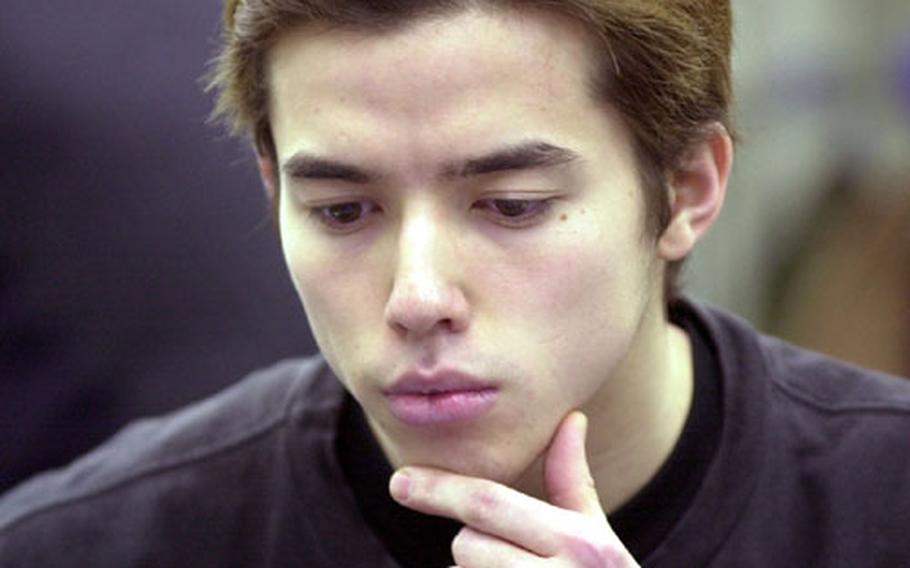
John O'Connor concentrates on a game of mah-jongg. (Jason Carter / S&S)
American John O’Connor is a celebrity … well, in mah-jongg circles anyway.
O’Connor shocked Japanese mah-jongg enthusiasts by taking second place in the first-ever mah-jongg world championship, held in Tokyo two months ago.
An ancient Chinese board game, mah-jongg is much more popular in Asia than in the United States.
But O’Connor, 22, isn’t the typical American: A 1998 Nile C. Kinnick High School graduate and the son of a former Marine, O’Connor has lived more than half of his life in Japan and is bilingual.
He’s a quick study in a game that has 88 different hands (international rules) and seems three times more complicated than chess.
“In chess, you don’t know what the other person is doing — you have to guess,” O’Connor said. In mah-jongg, “you’ve got to guess what three other people are doing.”
The game usually requires four players. There are 136 or 144 tiles in different suites. The object is to accumulate winning sets of these tiles. Mah-jongg is similar to many card games in that players score points for different hands. Players start with 13 tiles and win with 14.
In a handcrafted set, the tiles are smaller than playing cards, about the size of domino pieces. They are made of bone or bamboo, or sometimes of bone plaques mortised into bamboo.
O’Connor began playing mah-jongg about four years ago while a student at Sophia University in Tokyo.
“I always played it on video games. I never touched tiles until my friends were playing it” at the university, he said.
It took about three months “to actually get a feel for the game,” he said. He practiced with friends, even with strangers, in the Tokyo area’s many mah-jongg parlors.
“You just walk in and play with people you don’t know,” O’Connor said.
Since his performance at the world championship, though, O’Connor rarely goes unrecognized in mah-jongg circles.
“I walk in, and they’re like, ‘Oh, you’re second place,’ ” he said. “It’s kind of embarrassing, in a way. Everyone kind of expects you to do well, but you may have an unlucky day.”
Reporters from Japan’s mah-jongg magazines have interviewed O’Connor, and the Web site, www.mahjongnews.com, displays a digital photo of O’Connor on the champions’ podium, with the winner — a female Japanese professional mah-jongg player — and with the Japanese mah-jongg teacher who took third.
O’Connor said he never expected to walk away with a silver medal. His goal at the outset was just to finish higher than third or fourth in any game.
As he kept scoring points and winning hands, the pressure mounted.
“When everyone finds out you’re a contender for the championship, there’s all these cameras in your face. I felt like my brain was floating,” he said.
Ten different countries were represented, including China, Holland, Taiwan, Sweden and Russia.
Players dueled for eight games, playing six hours a day for two days.
O’Connor said his head throbbed after the tournament. The game is very psychological and requires strategy, he said.
“You have to look at the discard pile and read what kind of hand” an opponent is after, he said. “If I think this guy’s dangerous, I might play defensively, not offensively.”
The mah-jongg teacher “seemed shocked” when O’Connor beat him, he said.
Japan and China swept almost all the top 35 places; 100 people scored.
O’Connor represented the “USA Red” team, which placed eighth. There were three U.S. teams, each with four players. Ryan Morris, an American friend of O’Connor’s who works at Japan’s Mah-jongg Museum in Chiba, assembled the teams, O’Connor said.
O’Connor, who lives in Yokosuka and acts and does voice work in Japan, wants to start an international mah-jongg association in the country.
Not many foreigners in Japan play the game, he said. He’d like to start classes at U.S. military bases on the Kanto Plain, and perhaps form a team to compete in a world championship.
The next one tentatively is planned for China or the United States in 2003 or 2004, O’Connor said.
Anyone interested in joining O’Connor’s organization, or in taking a mah-jongg class, may call him at 0468-22-5036, or e-mail: jjfareast@ezweb.ne.jp.
Getting started ...
Where to buy: Mah-jongg sets are available in almost any thrift shop or hobby store in Japan.
Cost: Prices vary from 3,000 yen (about $25) for a cheap set to 30,000 yen (about $250) for a nice set.
What to buy: You need a mah-jongg set and a mah-jongg mat to play.